|
|
 |
Fiche d'espèce de Copépode |
|
|
Calanoida ( Ordre ) |
|
|
|
Diaptomoidea ( Superfamille ) |
|
|
|
Candaciidae ( Famille ) |
|
|
|
Candacia ( Genre ) |
|
|
| |
Candacia elongata (Boeck, 1872) (F,M) | |
| | | | | | | Syn.: | Candace elongata Boeck,1872; Giesbrecht, 1892 (p.425);
Candace robusta Wolfenden,1904 (p.140);
? C. inermis Cleve, 1904 a (p.200); Sewell, 1948 (p.431, 443, 460);
C. rotunda Wolfenden, 1904 (p.118, figs.F); van Breemen, 1908 a (p.148); T. Scott, 1911 (p.119); Lysholm & Nordgaard, 1921 (p.28);
C. rotundata : Farran, 1908 b (p.85, fig.M); 1926 (p.291); Sars, 1924 (p.46, Pl 125: F,M); Farran, 1926 (p.291); Sewell, 1948 (p.477, 479);
C. obtusa Sars, 1905 (p.23); Sewell, 1948 (p.468) | | | | Ref.: | | | Giesbrecht & Schmeil, 1898 (p.130); Sars, 1925 (p.346, figs.F,M); Rose, 1933 a (p.250, figs.F,M); ? Jespersen, 1934 (p.117); Lysholm & al., 1945 (p.41); Farran, 1948 b (n°13, p.3, figs.F,M); Grice, 1963 (p.176, figs.F,M, Rem.); Vervoort, 1965 (p.161, Rem.); Morris, 1970 (p.2301, 2319, figs.M, Rem.); Bradford, 1970 a (p.361, figs.F); Björnberg & al., 1981 (p.655, figs.F,M); Roe, 1984 (p.359); Baessa De Aguiar, 1991 (1993) (p.102, figs.M); Hure & Krsinic, 1998 (p.102); Lapernat, 1999 (p.11, 55, figs.F); Bradford-Grieve & al., 1999 (p.885, 956, figs.F,M); Bradford-Grieve, 1999 b (p.168, figs.F,M, Rem., figs.182, 193); Vives & Shmeleva, 2007 (p.448, figs.F,M, Rem.) | 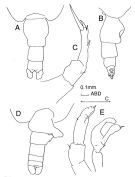 issued from : Bradford-Grieve J.M. in The Marine Fauna of New Zealand: Pelagic Calanoid Copepoda. National Institute of Water and Atmospheric Research (NIWA). NIWA Biodiversity Memoir, 111, 1999. [p.169, Fig.119]. Female: A, urosome (dorsal); B, idem (right lateral side); C, P5. Male: D, urosome (dorsal); E, P5.
|
 issued from : J.M. Bradford in N.Z. Jl Mar. Freshw. Res., 1970, 4 (4). [p.361, Figs 73-74]. Female (off Kaikoura, New Zealand): 73, urosome (dorsal); 74, P5. Scale bars represent 0.1 mm.
|
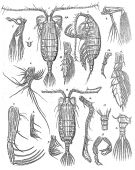 Issued from : G.O. Sars in Résult. Camp. Scient. Prince Albert I, 69, pls.1-127 (1924). [Pl.CXXV, figs.1-17]. As Candacia rotundata. Female: 1, habitus (dorsal); 2, idem (lateral left side); 3, rostrum; 4, A2; 5, Md; 6, Mx1; 7, Mx2; 8, Mxp; 9, distal segments of Mxp (enlarged); 10, P1; 11, P3; 12, P5. Male: 13, habitus (dorsal); 14, right A1; 15, P5; 16, urosome (dorsal); 17, last thoracic segment and three urosomal segments (lateral right side).
|
 issued from : R.N. Wolfenden in J; mar. biol. Ass. U.K., 1904, VII (N.S.). [Plate IX, Figs.10-11]. As Candace rotunda.
Female (from NE Atlantic): 10, habitus (dorsal); 11, P5.
|
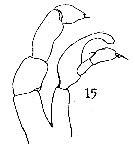 issued from : G.P. Farran in Fish. Ire. Sci. Invest., 1906, II [1908]. [Pl. IX, Fig.15]. Male (from W Ireland): 15, P5.
|
 issued from : B. Morris in J. Fish. Res. Bd Canada, 1970, 27 (12). [p.2318, Fig.11, K-N]; Male (from 34°49'N, 160°19'W): K, urosome (dorsal); L, Md (biting edge of gnathobase); M, Mx2; N, P5 (posterior). Nota: The male differs from previous descriptions of C. elongata (Giesbrecht & Schmeil, 1898; Sars, 1925; Rose, 1933); Farran, 1948, and Grice, 1963) in having 1- a deeper bifurcation of the basal tooth of the Md gnathobase: 2 - 4 small spines on the right 4th segment of P5 instead of 2; 3 - no spine on the right 3rd segment of P5; 4 - somewhat differently shaped processes on the right corner at the posterior prosome, and on the right sides of the urosomal segments 1 and 2 (that of the urosomal 2 being most different). Grice (1963) synonymized Candacia inermis Cleve, 1904, of which only the female has been described, with C. elongata, but he does regard inermis as a distinct type within the species. His report of one female of the inermis type from the tropical west Pacific. The male recorded here may be the inermis type male.
|
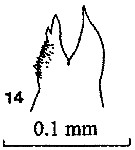 issued from P.E. Lapernat & C. Razouls in Vie Milieu, 2002, 52 (1). [p.23, Pl.VI). Female (from off Malta; Mediterranean Sea): 14, masticatory edge of Md. Nota: The Itoh's index: 4473.7 (number of teeth: 2).
|
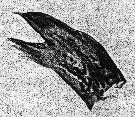 issued from : P.E. Lapernat & C. Razouls in Vie Milieu, 2002, 52 (1). [p.23, Pl. III, Fig.5]. Biting edge of Md gnathobase female (from off Malta, Mediterranean Sea).
|
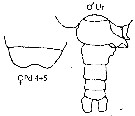 Issued from : J.M. Bradford-Grieve, E.L. Markhaseva, C.E.F. Rocha & B. Abiahy in South Atlantic Zooplankton, edit. D. Boltovskoy. 1999, Vol. 2, Copepoda; [p.1065, Fig. 7.366: Candacia elongata ]. Ur = urosome; B = basis; Pd = pedigerous segment. Female characters (from key, p.956): - P5 terminal segments end in one or more spine-like processes. - Posterior corners of prosome broadly rounded. Male characters (from key, p.956): - P5 is chelate on right; right A1 has teeth on one or more segments in geniculate region. - Left posterior corner of prosome rounded.
| | | | | Ref. compl.: | | | Pearson, 1906 (p.29); Massuti Alzamora, 1942 (p.111); Sewell, 1948 (p.506); C.B. Wilson, 1950 (p.181); Grice, 1963 a (p.496); Gaudy, 1963 (p.27, Rem.); Grice & Hulsemann, 1967 (p.19); Roe, 1972 (p.277, tabl.1, tabl.2); Vives & al., 1975 (p.52, tab.II, XII); Deevey & Brooks, 1977 (p.156, tab.2, Station "S"); Pipe & Coombs, 1980 (p.223, Table II, vertical occurrence); Vives, 1982 (p.294); Kovalev & Shmeleva, 1982 (p.85); Scotto di Carlo & Ianora, 1983 (p.150); Scotto di Carlo & al., 1984 (1043); Regner, 1985 (p.11, Rem.: p.37); Greze & al., 1985 (p.8); Heinrich, 1990 (p.19); Scotto di Carlo & al., 1991 (p.270); Gilabert & Moreno, 1998 (tab.1, 2); Lapernat & Razouls, 2001 (p.123, tab.1); Holmes, 2001 (p.30); Neumann-Leitao & al., 2008 (p.799: Tab.II, fig.6); Licandro & Icardi, 2009 (p.17, Table 4); Mazzocchi & Di Capua, 2010 (p.424); Medellin-Mora & Navas S., 2010 (p.265, Tab. 2); Zaafa & al., 2014 (p.67, Table I, occurrence); El Arraj & al., 2017 (p.272, table 2); Belmonte, 2018 (p.273, Table I: Italian zones) | | | | NZ: | 11 + 1 douteuse | | |
|
Carte de distribution de Candacia elongata par zones géographiques
|
| | | | | | | | | | | | | Loc: | | | ? Afr. S (in Cleve, 1904 a), Sao Tomé, G. of Guinea, off Mauritania, Moroccan coast, Canary Is., Brazil, Caribbean Sea, Caribbean Colombia, off Bermuda (Station "S"), Sargasso Sea, Azores, Bay of Biscay, off W Cape Finisterre, off Lisbon, off W Gibraltar, Norway, Wyville Thomson Ridge, Faroe Is., ? S Strait of Davis, off S Iceland, off W Ireland, off W Scotland, North Sea, Ibero-moroccan Bay, Medit. (M'Diq, Alboran Sea, G. of Lion, Marseille, Ligurian Sea, Tyrrhenian Sea, off Malta, Adriatic Sea Ionian Sea, Lebanon Basin), W & E Indian, Tasman Sea, New Zealand (Cook Strait), ? Philippines, ? Pacif. (N subtropical), Pacif. (SE tropical), Galapagos | | | | N: | 51 (Atlant. N: 22; Atlant. S: 4; Medit.: 17; Indian: 3; Pacif.: 5) | | | | Lg.: | | | (1) F: 3,5; (16) F: 3,2-3; M: 3,3-3,15; (24) M: 3,8; (38) F: 3,44; (92) M: 3,54; (199) F: 3,19; M: 3,04; (202) F: 3,25-3; M: 3,3-3,15; (313) F: 3,5; (340) F: 2,2-2; (909) F: 3,35; {F: 2,00-3,50; M: 3,04-3,80}
The mean female size is 3.057 mm (n = 11; SD = 0.5058), and the mean male size is 3.326 mm (n = 7; SD = 0.2632). The size ratio (male : female) is is approximately 1. | | | | Rem.: | méso-bathypélagique.
Un doute subsiste sur la synonymie de C. inermis, donc pour certaines localisations dans le Pacifique et l’Indien.
Le mâle décrit par Morris (1970) pourrait être celui de C. inermis si la synonymie n'est pas retenue.
Voir aussi les remarques en anglais | | | Dernière mise à jour : 25/10/2022 | |
|
|
 Toute utilisation de ce site pour une publication sera mentionnée avec la référence suivante : Toute utilisation de ce site pour une publication sera mentionnée avec la référence suivante :
Razouls C., Desreumaux N., Kouwenberg J. et de Bovée F., 2005-2025. - Biodiversité des Copépodes planctoniques marins (morphologie, répartition géographique et données biologiques). Sorbonne Université, CNRS. Disponible sur http://copepodes.obs-banyuls.fr [Accédé le 14 novembre 2025] © copyright 2005-2025 Sorbonne Université, CNRS
|
|
 |
 |












